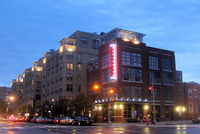U Street biz debate BID
Should the U Street area create a BID? Last night, business leaders from the U Street and 14th Street corridors debated that very question. A BID can clean the streets better and more often than DPW would on their own, add additional police officers, and better coordinate with city agencies. On the other hand, businesses and apartment buildings would pay for those services through another tax (8 cents per $100 of assessed value for commercial property, $96 per unit per year for residential). Good deal or no?
Constantine Stavropoulos, owner of Tryst and the Diner, and co-President and a founder of Adams Morgan’s BID, talked about his experience setting up that BID. It took a lot of time and many discussions with businesses, who asked the same questions. But ultimately, according to Stavropoulos, they’re pleased with the improvement in Adams Morgan made possible from added police and cleaner streets. Adams Morgan charges 21 cents per $100 of assessed value, almost three times the cost proposed for U Street. Stavropoulos is currently working to open another branch of Tryst and the Diner at 14th and T, within the boundaries of the proposed U Street BID.
Councilmember Jim Graham, who has been working closely with BID organizers, added that the BID should get a $125,000 grant from the DC Council available to small BIDs, which Adams Morgan also received. In addition, BIDs can get additional police officers at only half the actual rate, with the city covering the other half.
Business owners raised several concerns and questions. Some wondered why the BID organizers hadn’t done more outreach. Several had only heard of the BID when they received a notice in the mail, such as Kim Weeks of Boundless Yoga, who runs the Local First network of small businesses in the area. To many, hearing about this for the first time when there is already a set of bylaws and a printed map is too little, too late.
Councilmember Graham responded that he has urged small businesspeople to get involved, but several whom he approached personally were too busy. The organizers primarily worked with the “big guys” because if they didn’t support the BID, it would never happen. But Graham urged leaders to get involved and join the board. Without passing judgment on U Streets’s outreach efforts, Stavropoulos said that businesses had raised the same concerns during the Adams Morgan process, despite his best efforts. Nevertheless, many U Street business owners felt blindsided.
The BID’s boundaries are irregular, stretching up 14th from S Street as far as Clifton Place, west on U past 17th, part of New Hampshire Avenue, and some of Florida Avenue and 9th Street:
The boundaries include several large residential and mixed-use properties owned by developers including Chris Donatelli’s Donatelli Development and P. N. Hoffman, among the BID organizers. According to the proponents, this is a great opportunity for the BID to raise revenue from resiential buildings as well as retail businesses, keeping assessments low (Adams Morgan’s BID contains no residential buildings).
Skeptics, on the other hand, charge that this gerrymandered border ensures that the big property owners can push the BID through and control a majority of votes. Creating the BID requires affirmative votes from 51% of total assessed value and 25% of the total properties. Jonathan Chudnoff of Go Mama Go claimed that the five biggest buildings already comprise the 51% needed for the first of the two criteria. Likewise, votes for the BID’s Board of Directors depend on the size of each business’s BID tax, which is based on assessment, so a coalition with 51% of assessment value would effectively control the Board.
Others argued that the BID lacked a business plan or clear budget, and wanted to know how their money would be spent. Graham strongly disputed this point, claiming that there is indeed a business plan and budget, which organizers worked hard to trim to minimize the assessment. Rather than worry about the past, Graham urged people to focus on the future. There are openings for business leaders to join the BID board and get involved. On the other hand, Dante Ferrando of the Black Cat argued that joining the board would mean supporting the BID, and he at least wasn’t willing to do that until he was confident he could support it.
Several businesspeople, such as Greg Link of HomeRule, David Schaefer of Urban Essentials and John Snelgrove of Saint-Ex, asked for the southern boundary to extend beyond S Street. While S (the east side) is a boundary between Wards 1 and 2, between Dupont, Logan, and U Street ANCs, and between Police Service Areas, it’s one retail corridor and the businesses there share marketing for events like Dog Days. BID organizers replied that it’s easier to extend the boundaries once the BID is established, and that they’d be happy to extend the BID down 14th (if businesses in Logan Circle want to join). They also hope to grow the BID to lower Georgia Avenue to incorporate the upcoming Howard Town Center area.
Toward the end of the discussion, I threw in the possibility of raising more money without taxing businesses through performance parking, which has worked so well in Pasadena. DC has the framework to do the same in Columbia Heights and around Eastern Market, though thus far DDOT hasn’t yet installed enough multispace meters to actually implement the vision of a performance parking district.


